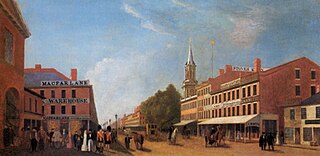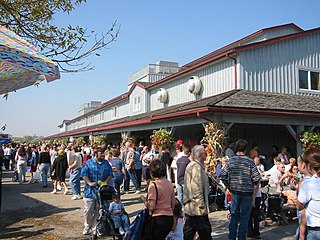
The Toronto Eaton Centre is a shopping mall and office complex in the downtown core of Toronto, Ontario, Canada. It is owned and managed by Cadillac Fairview (CF). It was named after the Eaton's department store chain that once anchored it before the chain became defunct in the late 1990s.

St. Lawrence is a neighbourhood located in downtown Toronto, Ontario, Canada. The area, a former industrial area, is bounded by Yonge, Front, and Parliament Streets, and the Canadian National railway embankment. The Esplanade off Yonge St., lined with restaurants, cafés and hotels runs through the middle of the area. In previous times, the area was sometimes referred to as 'St. Lawrence Ward' or more often today as 'St. Lawrence Market', synonymous with the large retail vendor market which is the neighbourhood's focal point. The area is the site of a large city-sponsored housing project of the 1970s, which revitalized an old 'brownfields' area. The boundaries of the St Lawrence Neighbourhood Association and the St Lawrence Market BIA are somewhat larger than those noted above. Both groups have boundaries that extend from Yonge to Parliament Streets and Queen Street East to the rail corridor.

King Street is a major east–west commercial thoroughfare in Toronto, Ontario, Canada. It was one of the first streets laid out in the 1793 plan of the town of York, which became Toronto in 1834. After the construction of the Market Square in 1803 at King and Jarvis streets, to house the first St. Lawrence Market farmer's market, the street became the primary commercial street of York and early Toronto. This original core was destroyed in the 1849 Great Fire of Toronto, but subsequently rebuilt. The original street extended from George to Berkeley Street and was extended by 1901 to its present terminuses at Roncesvalles Avenue in the west and the Don River in the east.

The St. Lawrence Market South building is a major public market building in Toronto, Ontario, Canada. It is located on the southwest corner of Front and Lower Jarvis Streets. Along with the St. Lawrence Market North and St. Lawrence Hall, it comprises the St. Lawrence Market complex. The current building was opened in 1902, incorporating the 1845 Toronto City Hall building into the structure. The building was restored during the 1970s.

Reading Terminal Market is an enclosed public market located at 12th and Arch Streets in Center City Philadelphia, Pennsylvania. It opened originally in 1893 under the elevated train shed of the Reading Railroad Company after the city of Philadelphia advocated to move public markets from the streets into indoor facilities for both safety and sanitary reasons. When the Center City Commuter Connection was completed in 1984, the Reading Terminal ceased operating as a train station, impacting foot traffic at the Market. The Reading Company then proposed using the Reading Terminal complex as the site for a new convention center. The site was chosen for the convention center, and in 1990 the Company transferred title to the complex to the Pennsylvania Convention Center Authority. Presently, the Market still occupies the ground floor and basement levels of the Reading Terminal's former train shed which is now part of the Pennsylvania Convention Center. Vendor stalls occupy the ground floor with entrances on Filbert Street to the South, Twelfth Street to the West, and Arch Street to the North. The stalls are arranged in a grid pattern with an open area in the center with tables and seating. Over one hundred merchants offer fresh produce, meats, fish, artisan cheese, groceries, ice cream, flowers, grilled cheese, baked goods, crafts, books, clothing, and specialty and ethnic foods. Two of the vendors are descendants of original merchants from the initial opening in the late 1800s. The basement floor of the market holds the state-of-the-art refrigerated storage area for vendor use. Currently, the market is open every day of the week, although the Pennsylvania Dutch merchants generally do not operate Sunday through Tuesday.

Western Market is one of the oldest structures in Sheung Wan, Hong Kong Island, Hong Kong. The current structure, built in 1906, was the North Block of the original Western Market. It is the oldest surviving market building in the city. The former South Block was demolished in 1981 and its site is now occupied by the Sheung Wan Complex.

Niagara is a neighbourhood in Toronto, Ontario, Canada, located south of Queen Street West; it is usually bordered by Strachan Avenue to the west, Bathurst Street to the east, and the railway corridor to the south, and so named because Niagara Street runs through the centre of it. The eastern portion of this area was first planned as the New Town Extension when Toronto was incorporated as a city. The area was developed as a residential area for the workers of industries located along the CN and CP railway corridors. It remains a working-class neighbourhood that has seen the development of new condominium apartment buildings.

The cuisine of Toronto reflects Toronto's size and multicultural diversity. Different ethnic neighbourhoods throughout the city focus on specific cuisines, such as authentic Chinese and Vietnamese found in the city's Chinatowns, Korean in Koreatown, Greek on The Danforth, Italian cuisine in Little Italy and Corso Italia, and Indian/Pakistani in Little India. Numerous other world cuisines are available throughout the city, including Portuguese, Hungarian, Japanese, and Caribbean. Toronto's large Jewish population has also ensured a variety of Jewish restaurants and delis, with varying adherence to kosher rules. In addition to ethnic cuisines, Toronto is also home to many fine dining establishments and chain restaurants ranging from fast food to casual or upscale dining.

Chelsea Market is a food hall, shopping mall, office building and television production facility located in the Chelsea neighborhood of the borough of Manhattan, in New York City. The Chelsea Market complex occupies an entire city block with a connecting bridge over Tenth Avenue to the adjacent 85 Tenth Avenue building. The High Line passes through the 10th Avenue side of the building.

Downtown Toronto is the main central business district of Toronto, Ontario, Canada. Located entirely within the district of Old Toronto, it is approximately 17 square kilometres in area, bounded by Bloor Street to the northeast and Dupont Street to the northwest, Lake Ontario to the south, the Don Valley to the east, and Bathurst Street to the west. It is also the home of the municipal government of Toronto and the Government of Ontario.

The Jacksonville Landing was a festival marketplace in Downtown Jacksonville, Florida. It was located at the intersection of Independent Drive and Laura Street, along the Jacksonville Riverwalk. It was built by the Rouse Company at a cost of $37.5 million and opened in 1987 and officially closed after the 4th of July festivities in 2019. Demolition commenced around October 8, 2019. The 126,000 square feet (11,706 m2) center was comparable to New York City's South Street Seaport, Boston's Faneuil Hall and Miami's Bayside Marketplace, all developed by Rouse.
St. Andrew's Playground is a small park in downtown Toronto. It is located at the 450 Adelaide Street West, at the northwest corner of Brant St and Adelaide. It has a playground for children and an off-leash area for dogs that is surrounded by a short fence, with an accessible water fountain for pets, children, and adults. A Heritage Toronto plaque in the northwest corner describing the history and significance of the park was installed in 2007.

The Ontario Food Terminal is the main produce distribution centre for Toronto, Ontario, Canada. It is located at 165 The Queensway at Park Lawn Road, north of the Gardiner Expressway, and west of the Humber River. The U-shaped building occupies 1,740,000 square feet (162,000 m2) of a 40 acres (16 ha) site and includes 80,000 square feet (7,400 m2) of cold storage and is open 24 hours a day, 365 days a year for deliveries. Annually some one million vehicles arrive at the centre delivering produce from across North America or leave to distribute it to stores and restaurants across the city. It is the largest such facility in Canada, and the third largest in North America after those in Chicago and Los Angeles.

St. Lawrence Market is a major public market in Toronto, Ontario, Canada. It is located along Front Street East and Jarvis Street in the St. Lawrence neighbourhood of downtown Toronto. The public market is made up of two sites adjacent to one another east of Jarvis Street, St. Lawrence Market North, and St. Lawrence Market South. St. Lawrence Market South is situated south of Front Street East, and is bounded by The Esplanade to the south. St. Lawrence Market North is situated north of Front Street East, and is bounded by St. Lawrence Hall to the north.

St. Lawrence Market North is a public market in Toronto, Ontario, Canada. It hosts a variety of markets, including a farmers' market, an antique market and Christmas trees daily from mid-Nov. to Dec. 24. The site has been a farmer's market since 1803. Several buildings have been built for the Market North, the most recent in 1968. The new Market North structure is now under construction. The St. Lawrence Market combines the North building, the St. Lawrence Hall and the St. Lawrence Market South building.

The Great Fire of Toronto of 1849, April 7, 1849, also known as the Cathedral Fire, was the first major fire in the history of Toronto, Ontario, Canada. Much of the Market Block, the business core of the city, was wiped out, including the predecessor of the current St. James Cathedral. The 1831 building of the Toronto City Hall and St. Lawrence Market south of King was damaged and was torn down.

St. Jacobs Farmers' Market is a farmers' market and flea market in Waterloo, Ontario, Canada. It is located to the south of King Street North, to the east of Weber Street North, and to the west of the railway tracks. It is the largest year-round farmer's market in Canada, and is a popular destination for residents of the town and nearby communities, as well as tourists from Canada, the United States, and Europe. It draws about 1 million visitors annually.

A food hall is a large standalone location or department store section where food and drinks are sold.

The St. Roch Market is a building on the median of St. Roch Avenue facing St. Claude Avenue in New Orleans. It was built in 1875, with extensive renovations in 1937-1938 and 2012-2015.

Essex Market is a food market with independent vendors at the intersection of Essex Street and Delancey Street in the Lower East Side of Manhattan, New York City. The market is known for its many local shops, including grocery stores, bakeries, butchers, seafood shops, coffee vendors, cheese shops, and spice shops. There are small restaurants that serve meals in the market, including Shopsin's. The LES Girls Club and Cuchifritos Gallery + Project Space are also included in the market.



















